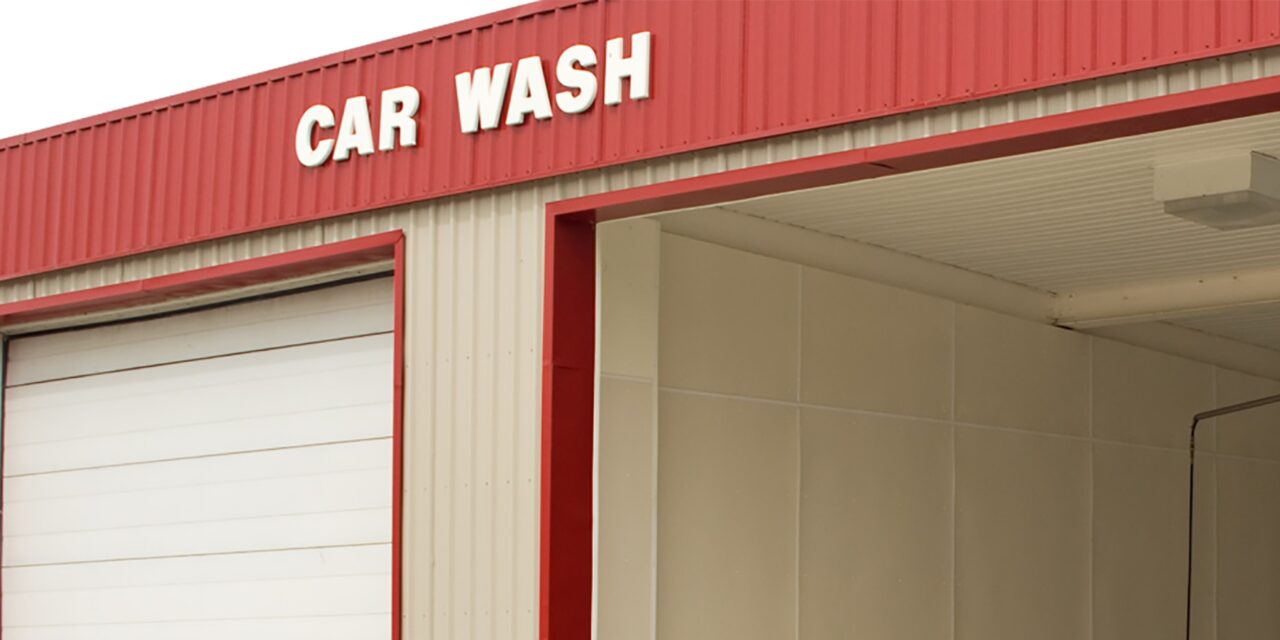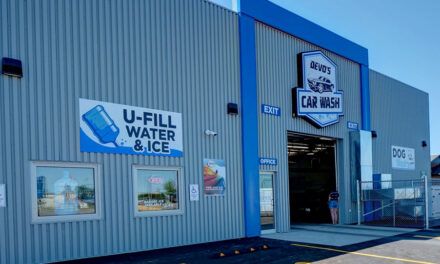
WHY DO I NEED CARWASH DOORS?

WHY DO I NEED DOORS?
by Josh Hart
And, what style is best for my application?
The main reason carwashes utilize doors in carwash applications is for one of two reasons, either to retain heat in a bay or to offer security when the wash is closed. If you operate in cold climates, doors are a necessity to keep your equipment from freezing during the winter months.
There are however many other reasons that certain types of carwashes use doors.
- Noise reduction: With many new washes going up in highly populated areas, noise can be a problem for local residences or businesses. Many cities will now require doors specifically for the purpose of reducing noise level in these highly-populated areas. The typical polycarbonate door is constructed of 5/8-inch thick multi-wall polycarbonate. Having multiple layers will greatly increase the amount of sound blocked by the door. A polycarbonate panel will reduce the noise level from the wash by approximately 21 db. A vinyl roll up door on the other hand is a single layer typically constructed of 22 oz vinyl material. However, if the door properly seals the opening, this type of door can reduce the noise level by approximately 15 db.
- Traffic flow: Traffic flow in any rollover or tunnel wash can be tricky. There are normally signs or lights to signal when a vehicle should enter the bay, but if a customer is not paying attention to these signals, they may enter the wash at the wrong time and throw off the wash cycle. Having doors that open and close between wash cycles can clearly define the appropriate times for the vehicles to enter and exit the wash bay.
- Wind reduction: This is important in all types of carwash applications. Often, a carwash bay can create a wind tunnel. With too much wind, the chemical is blown everywhere but on the car like it should be and can affect the finished wash. In warmer climates, many people add just one door to solve this problem. In the self-serve application where people exit their vehicles one or two doors will not only block the wind, but provide a warmer, more enjoyable washing experience for the customer.
- Water run off: Doors not only keep the chemical from spraying outside of the bay from the wind, but can eliminate water runoff that should be going in the drains from running out of the wash into the parking lot or streets.
What are the differences between vinyl and polycarbonate doors, and are other types available?
There are many types of doors available in the market, but only two styles that have been designed for and have succeeded in the carwash application. The first style and the most popular over the last few decades has been the overhead polycarbonate style. The other style is a vinyl roll up door. Vinyl roll up doors have been around forever, but have only been modified and used in the carwash market for the last nine to 10 years. Both style doors have clear panels to allow natural light into the bay and both are constructed of corrosion resistant hardware to survive the tough environment. The big differences come down to a few key items.
- Speed: A polycarbonate overhead door can be paired with a pneumatic opener or an electric opener and will typically operate at speeds up to 18 inches per second. However, the vinyl roll up door is only available with an electric model opener and will operate at speeds of up to 34 inches per second giving it a slight edge over overhead style when you are opening and closing the door after every car.
- Security: The edge definitely goes to the polycarbonate door in this category. The polycarbonate used in the sectional overhead doors has an impact resistance 200 times that of a glass panel. It can take impacts comparable to that of a steel door, but does not leave dents to show for it. Paired with a pneumatic opener that holds pressure from the operator on the door in the closed position it is very difficult to break through or lift this style door. The vinyl roll up door on the other hand offers no security level whatsoever. You can easily lift the door up or cut through the vinyl to gain access to the bay. However, the vinyl style door can be mounted on the outside of the building or inside a separate security style door if you want to run this type of door between every car and just have the security door to close at night.
- R-Value: This is a category that does not easily provide a clear-cut winner. Your typical polycarbonate door will offer an R-value around three to four where a vinyl roll up door does not have a registered R-Value. However, by operating the vinyl door up to twice as fast you can retain much of the heat in your bay that escapes when the doors open and close.
- Knock out ability: The edge here goes to vinyl roll up styles. Most are designed with the ability to break out of the tracks when impacted and have a reset feature that will pull the door back into the track on the next cycle. The polycarbonate doors will most likely suffer damage on impact and will require replacement panels to fix the door. Therefore, with roll up doors you suffer less downtime if your door is impacted and avoid the repair costs to replace the door panels with overhead doors.
- Appearance: This one comes down to personal preference. With the vinyl roll up door you must have a solid top panel, but can mix and match the intermediate panels with clear panels or colored vinyl. Many people like the look of the colored vinyl where others prefer the straight anodized aluminum and polycarbonate of the overhead style door.
Once I determine the style of door that works best for my application are there other things to consider?
Let’s start by breaking down the two styles. If you determined that a polycarbonate overhead door would work best for you there are a number of items to consider at the time of purchase:
- Hardware options: When purchasing a door for a carwash environment, there is a good chance that it is going to get a lot of water and chemical spray on the door itself and attached hardware. If you purchase a door package consisting of corrosion resistant components you will greatly reduce the amount of maintenance required down the road. Plastic hinges, plastic track, stainless steel bearings, shaft, and hardware have a lifespan over double your standard components with little or no maintenance. A key factor on the overhead style polycarbonate door is to look at the Strapeze Counterbalance System instead of torsion springs to balance your door. The best torsion springs are only good for 100,000 cycles while the Strapeze system is rated for 500,000 cycles. To get the max life out of your springs you need to grease them on a regular basis and the grease drips down on your door panels. The Strapeze system requires zero maintenance. Furthermore, to replace your springs you need to take down your shaftline to perform the work where the Strapeze system is mounted off to the side of the door and can be worked on without removing any other components of the door. The Strapeze Counterbalance System is only recommended on doors that have an automatic opener and not for use on manually operated doors.
- Operator styles: There are really only two styles to choose from when it comes to openers for overhead doors. The first is a pneumatic opener. The most popular style pneumatic opener is a direct drive style opener. It attaches directly to the door to open and close the door. By attaching directly to the door and not turning the shaft to operate the door, the door and operator are always in sync. This ensures that if the door stops for any reason the operator also stops which eliminates the possibility of the cables slacking and coming off the cable drums on the shaft. Pneumatic openers are constructed of anodized aluminum or stainless steel making them ideal for the carwash environment. They are also designed to operate at very high cycles so you can open and close the door between every car. The other style is an electric opener. There are a lot of different options when it comes to electric overhead door openers, but very few are actually designed for the carwash environment. The most popular style is a jack shaft opener that has been modified with stainless steel drive shaft and coated windings inside the motor. This style opener has proven successful in the carwash market. However, you need to keep in mind that this style opener turns the shaft rather than attaching directly to the door so you are more prone to cable jumping as mentioned above.
If you decided that the roll up style door is best for you there are fewer options to consider. Most of the time these doors are designed as a package. Be sure to confirm with your door supplier that the door you choose was manufactured specifically for the carwash environment. Some of the items to look for would be stainless steel shaftline, stainless steel bearing plates, stainless steel bearings, stainless steel fasteners, and tracks made of a corrosion resistant material. The best operator for these style doors is an electric jackshaft model. There are no cables with this style door so cable jumping is not an issue. There are many options with colors and clear panels available so reach out to the manufacturer to get a complete spec sheet showing your options.
If you have reviewed all the above information you should have a better idea of what style door would work best for your application. Verifying that the hardware package you chose consists of materials designed for the carwash environment will drastically reduce the maintenance on your doors as well as the long-term performance of your system. Regardless of what style you choose, your doors need to be cleaned regularly to maintain a new appearance. All of the chemical used to clean your car ends up getting sprayed all over the door and hardware. It is sprayed off the car in the wash process, but ends up building up on the door panels if they are not cleaned off regularly. Contact your door manufacturer or distributor to get recommendations on what works best to clean your style of door. Manufacturer’s websites usually offer a variety of resources such as owner’s manuals, maintenance manuals, and specification sheets that can also help you to make a well-informed decision.
Josh Hart is the president of Airlift Doors, Inc. and can be contacted at jhart@airliftdoors.com 612-529-1000 #106.


































